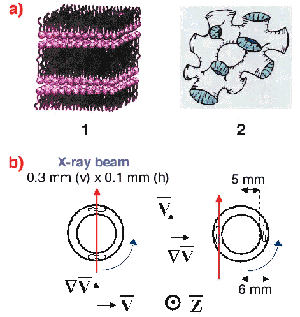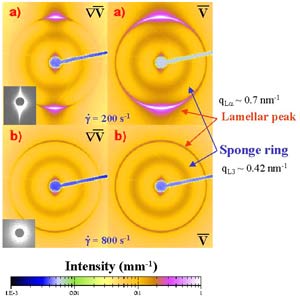- Home
- Users & Science
- Scientific Documentation
- ESRF Highlights
- ESRF Highlights 2000
- Soft Condensed Matter
- Ribbon Phase in a Two-Phase Shear Flow
Ribbon Phase in a Two-Phase Shear Flow
Dispersing one fluid into another immiscible one is an everyday experience that requires stirring to rupture large drops into small droplets. The interplay between surface tension, viscosity and shear flow leads to the deformation and break-up of the drops. If the viscosities of both phases are similar, the dispersed phase forms droplets of the order of the break-up size Rb ![]()
![]() / (
/ (![]()
![]() ), where
), where ![]() is the surface tension,
is the surface tension, ![]() the viscosity and
the viscosity and ![]() the shear rate. In a phase-separating fluid mixture, the competition between flow and coarsening results in a very different steady state - the so-called "string phase" [1] consisting of strikingly elongated cylindrical domains along the flow direction. In this study, we have investigated the effect of shear flow in a different type of fluid, a phase-separated lyotropic lamellar-sponge mixture, where one of the coexisting phases (lamellar) possesses bending elasticity. As depicted in Figure 28a, the membranes are stacked with smectic order in the lamellar phase (L
the shear rate. In a phase-separating fluid mixture, the competition between flow and coarsening results in a very different steady state - the so-called "string phase" [1] consisting of strikingly elongated cylindrical domains along the flow direction. In this study, we have investigated the effect of shear flow in a different type of fluid, a phase-separated lyotropic lamellar-sponge mixture, where one of the coexisting phases (lamellar) possesses bending elasticity. As depicted in Figure 28a, the membranes are stacked with smectic order in the lamellar phase (L![]() ), whereas the sponge phase (L3) is made up of disordered and multiply-connected membranes [2]. The additional role of bending elasticity can modify the microstructure under a shear flow [3]. These effects are manifested over many different length scales, as a result, complementary techniques of small-angle X-ray and light scattering combined with rheo-physical probes become essential in these studies.
), whereas the sponge phase (L3) is made up of disordered and multiply-connected membranes [2]. The additional role of bending elasticity can modify the microstructure under a shear flow [3]. These effects are manifested over many different length scales, as a result, complementary techniques of small-angle X-ray and light scattering combined with rheo-physical probes become essential in these studies.
 |
Fig. 28: a) Schematic views of (1) a lamellar phase formed by the periodic arrangement of surfactant membranes and (2) a sponge structure composed of randomly interconnected membranes; b) Couette flow scattering geometry used for the SAXS experiments. The sample is contained between the cylinders and the red arrow indicates the trajectory of the beam. The vorticity direction is parallel to the axis of the cylinders (
|
The samples were composed of brine (water + 20 g/l of NaCl), surfactant (SDS), and co-surfactant (octanol). The phase diagram of this system exhibits a coexisting region between L![]() and L3 phases that can be made macroscopically homogeneous by steady shear. Experiments were performed on the ID2 beamline using a couette flow geometry as shown schematically in Figure 28b. From the SAXS pattern observed along the radial (
and L3 phases that can be made macroscopically homogeneous by steady shear. Experiments were performed on the ID2 beamline using a couette flow geometry as shown schematically in Figure 28b. From the SAXS pattern observed along the radial (![]()
![]() ) and tangential (
) and tangential (![]() ) directions of the flow, the orientation of each coexisting phase can be probed independently. The viscosity of this two-phase mixture exhibits two different Newtonian regimes separated by a shear thickening transition. Figure 29 displays the SAXS pattern in (
) directions of the flow, the orientation of each coexisting phase can be probed independently. The viscosity of this two-phase mixture exhibits two different Newtonian regimes separated by a shear thickening transition. Figure 29 displays the SAXS pattern in (![]() ,
,![]() ) and (
) and (![]()
![]() ,
,![]() ) planes at these two different shear regimes (a and b). The orientation of the L3 phase is isotropic whereas the L
) planes at these two different shear regimes (a and b). The orientation of the L3 phase is isotropic whereas the L![]() phase is strongly anisotropic in the low shear regime, with most of the membranes oriented perpendicular to the vorticity direction (
phase is strongly anisotropic in the low shear regime, with most of the membranes oriented perpendicular to the vorticity direction (![]() ). The proportion of membranes of the L
). The proportion of membranes of the L![]() phase oriented in the (
phase oriented in the (![]()
![]() ) and (
) and (![]()
![]() ,
,![]() ) planes is determined by comparing the intensity of the corresponding Bragg peaks along the different directions, using the isotropic intensity of the L3 phase as a reference. We found that IZ / IV
) planes is determined by comparing the intensity of the corresponding Bragg peaks along the different directions, using the isotropic intensity of the L3 phase as a reference. We found that IZ / IV ![]() 70 and IZ / I
70 and IZ / I![]() V
V ![]() 9 , where IZ, IV and I
9 , where IZ, IV and I![]() V are the intensities of the lamellar Bragg peak along the vorticity, flow velocity and shear gradient directions, respectively. The Inset of Figure 29a depicts the small-angle light scattering in the (
V are the intensities of the lamellar Bragg peak along the vorticity, flow velocity and shear gradient directions, respectively. The Inset of Figure 29a depicts the small-angle light scattering in the (![]() ,
,![]() ) plane which exhibits a streak pattern in the low shear regime (a), indicating the presence of very elongated structures in the flow direction. These results demonstrate the existence of a new type of instability in which the coexisting lamellar phase forms elongated multilamellar structures along the flow velocity.
) plane which exhibits a streak pattern in the low shear regime (a), indicating the presence of very elongated structures in the flow direction. These results demonstrate the existence of a new type of instability in which the coexisting lamellar phase forms elongated multilamellar structures along the flow velocity.
 |
Fig. 29: Measured SAXS patterns along the two different flow geometries indicated in Figure 28b: a) In the low shear rate regime the system is very anisotropic corresponding to the formation of multi-lamellar ribbons; b) At high shear rates, these ribbons transform to multi-lamellar vesicles. Insets depict the small-angle light scattering pattern observed in the (
|
The unique orientation of the lamellae along the (![]() ,
,![]() ) and (
) and (![]()
![]() ,
,![]() ) planes, together with the intensity ratios along different directions and the streak pattern observed in the small-angle light scattering establish that these elongated structures are ribbon-like. The large lamellar droplets observed at rest result from the fragmentation of these ribbons via the Rayleigh instability. At high shear rates, these multilamellar ribbons become unstable and transform into monodisperse vesicles as indicated by the nearly isotropic SAXS patterns in Figure 29b and the disappearance of streak pattern in small-angle light scattering. In summary, we have shown that a coexisting lyotropic lamellar-sponge phase mixture becomes unstable to shear flow resulting in the formation of ribbon-like structures.
) planes, together with the intensity ratios along different directions and the streak pattern observed in the small-angle light scattering establish that these elongated structures are ribbon-like. The large lamellar droplets observed at rest result from the fragmentation of these ribbons via the Rayleigh instability. At high shear rates, these multilamellar ribbons become unstable and transform into monodisperse vesicles as indicated by the nearly isotropic SAXS patterns in Figure 29b and the disappearance of streak pattern in small-angle light scattering. In summary, we have shown that a coexisting lyotropic lamellar-sponge phase mixture becomes unstable to shear flow resulting in the formation of ribbon-like structures.
References
[1] T. Hashimoto, K. Matsuzaka, E. Moses and A. Onuki, Phys. Rev. Lett., 74, 126, (1995).
[2] Surfactants and Polymers in Aqueous Solution, B. Jönsson et al. John Wiley & Sons (1998).
[3] D. Roux, in Theoretical Challenges in the Dynamics of Complex Fluids, Ed. T. McLeish, Kluwer Academic (1997).
Authors
G. Cristobal (a), J. Rouch(a), P. Panizza(a) and T. Narayanan (b).
(a) Université Bordeaux I (France)
(b) ESRF



